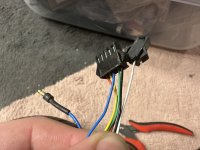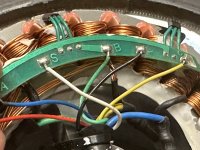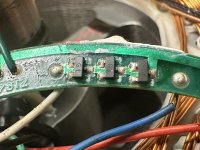chuyskywalker
1 kW
So, I've got these 8.5" hoverboard motors and they're pretty bog standard as far as direct drive hub motors go; 3 phase, 3 halls, and a 5v pos/negative. However, there is mystery white wire coming off the motor as well.

Now I follow it inside, and it's hooked up to this "S" pad. Now, you might think "S for Speed" -- but that'd be kinda...dumb. This is a direct drive motor, each hall signal is a speed sensor if you know the pole count. So that doesn't make much sense.

The next, most common, reasonable guess would be that it's a temperature sensor. Dunno why you'd label that "S" (maybe "S"ensor?). So, you try to see what the PCB leads to and...

What in tarnation is going on here?
In every motor I've dealt with, temp is done with thermistors (PTC/NTC/whatever) which is just a heat driven resistor. If this is a temp sensor, how the heck does this work and what even is it doing?
Or, am I wildly off and it's neither speed nor temp but something else entirely I've never seen before?
What the heck am I looking at here?
(The trace that the white wire eventually connects to is ground)

Now I follow it inside, and it's hooked up to this "S" pad. Now, you might think "S for Speed" -- but that'd be kinda...dumb. This is a direct drive motor, each hall signal is a speed sensor if you know the pole count. So that doesn't make much sense.

The next, most common, reasonable guess would be that it's a temperature sensor. Dunno why you'd label that "S" (maybe "S"ensor?). So, you try to see what the PCB leads to and...

What in tarnation is going on here?
In every motor I've dealt with, temp is done with thermistors (PTC/NTC/whatever) which is just a heat driven resistor. If this is a temp sensor, how the heck does this work and what even is it doing?
Or, am I wildly off and it's neither speed nor temp but something else entirely I've never seen before?
What the heck am I looking at here?
(The trace that the white wire eventually connects to is ground)

